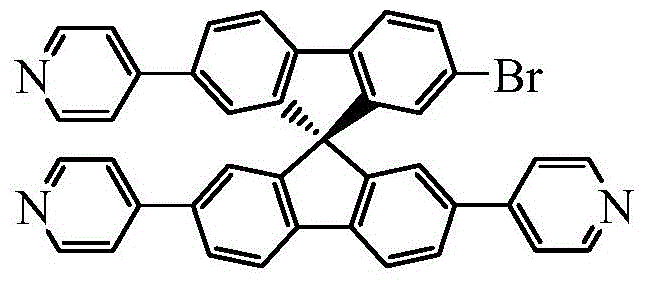Spirofluorene pyridine palladium nanoparticles and preparation method thereof
A technology of spirofluorenpyridine palladium and spirofluorenpyridine, which is applied in the field of spirofluorenpyridine palladium nanoparticles and its preparation, can solve the problems of shape, distribution and particle size of nano-catalysts, and achieve low cost, stable performance and high reactivity Effect
- Summary
- Abstract
- Description
- Claims
- Application Information
AI Technical Summary
Problems solved by technology
Method used
Image
Examples
Embodiment 1
[0031] Quickly add 10mL of 5.0mmol / L palladium chloride aqueous solution to 10mL of 5.0mmol / L spirofluorenepyridine ethylene glycol solution into a 50mL three-neck flask, stir vigorously at room temperature for 15 minutes, and then carry out microwave reflux reaction for 20 Minutes, cooled and aged at room temperature for 3 hours. The aged product was centrifuged, and the precipitate was washed three times with deionized water and ethanol, ultrasonically dispersed, and dried to obtain the spirofluorenepyridine palladium nanoparticles. Observe the morphology of the nanoparticles with a scanning electron microscope, such as figure 2 As shown, the particle size of nanoparticles is 20-100nm.
[0032] Wherein, the preparation method of the spirofluorenpyridine comprises: 2,2',7,7'-tetrabromo-9,9'-spirobifluorene (3.0mmol, 1.91g), 4-pyridineboronic acid (9.0mmol, 1.12g), potassium carbonate (40.0mmol, 5.52g), toluene / ethanol / water (80mL / 30mL / 20mL) were added to a 250mL three-neck...
Embodiment 2
[0034] Quickly add 10mL of 10mmol / L palladium chloride aqueous solution into a 50mL three-necked flask containing 10mL of 5.0mmol / L spirofluorenepyridine ethyl acetate solution, stir vigorously at room temperature for 15 minutes, then carry out microwave reflux reaction for 40 minutes, cool Then aged at room temperature for 5h. The aged product was centrifuged, and the precipitate was washed three times with deionized water and ethanol, ultrasonically dispersed, and dried to obtain the spirofluorenepyridine palladium nanoparticles. The morphology of the nanoparticles was observed with a scanning electron microscope.
Embodiment 3
[0036] Quickly add 10mL of 5.0mmol / L palladium acetate aqueous solution into a 50mL three-neck flask containing 10mL of 1.0mmol / L spirofluorene pyridine glycol solution, stir vigorously at room temperature for 15 minutes, and then carry out microwave reflux reaction for 30 minutes, After cooling, it was aged at room temperature for 4 hours. The aged product was centrifuged, and the precipitate was washed three times with deionized water and ethanol, ultrasonically dispersed, and dried to obtain the spirofluorenepyridine palladium nanoparticles. The morphology of the nanoparticles was observed with a scanning electron microscope.
[0037]With embodiment 1, the spirofluorene pyridine palladium nano-particle prepared by embodiment 2 and embodiment 3 is example, carry out catalytic reaction:
[0038] Use the spirofluorenepyridine palladium nanoparticles prepared in the above example 1 as a catalyst to carry out the catalytic reaction, the reaction conditions are: 1.0mmol 4-bromox...
PUM
| Property | Measurement | Unit |
|---|---|---|
| particle diameter | aaaaa | aaaaa |
Abstract
Description
Claims
Application Information
 Login to View More
Login to View More - R&D
- Intellectual Property
- Life Sciences
- Materials
- Tech Scout
- Unparalleled Data Quality
- Higher Quality Content
- 60% Fewer Hallucinations
Browse by: Latest US Patents, China's latest patents, Technical Efficacy Thesaurus, Application Domain, Technology Topic, Popular Technical Reports.
© 2025 PatSnap. All rights reserved.Legal|Privacy policy|Modern Slavery Act Transparency Statement|Sitemap|About US| Contact US: help@patsnap.com



